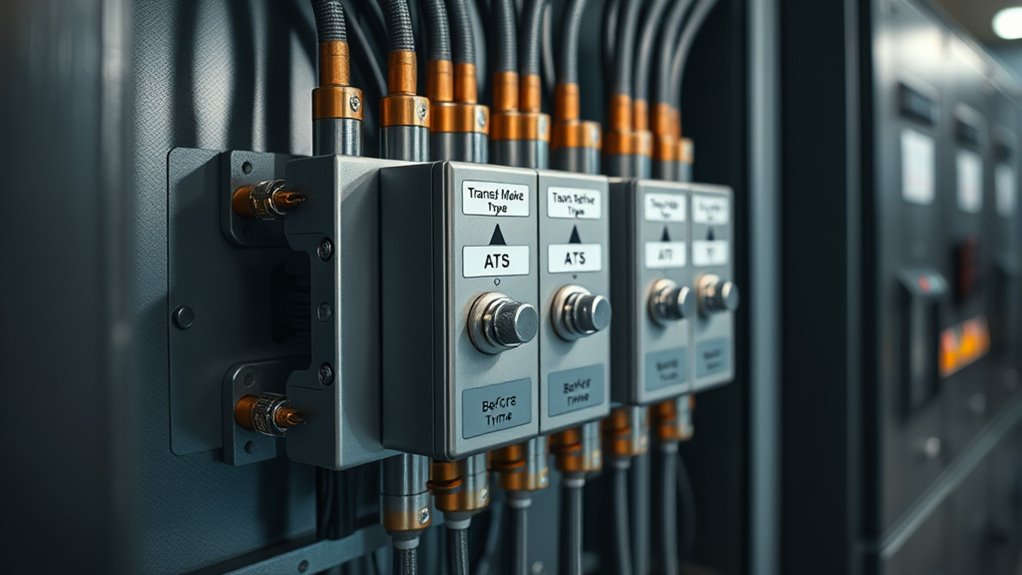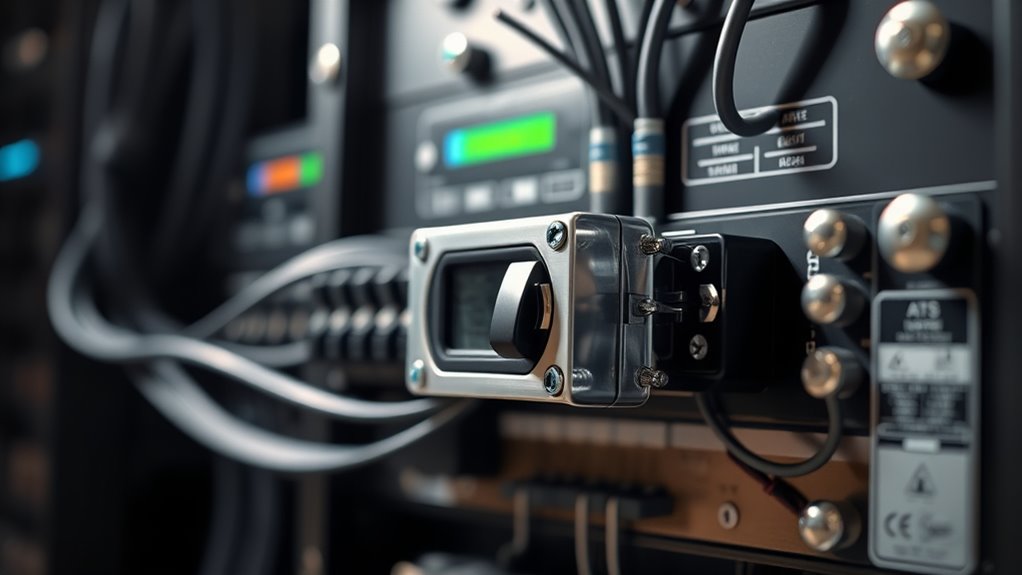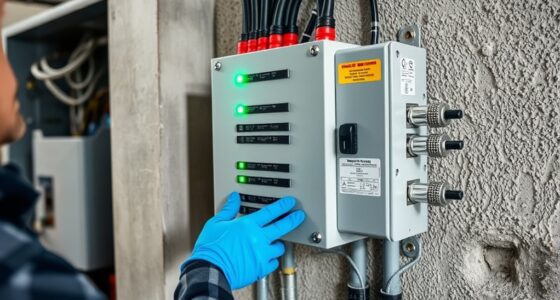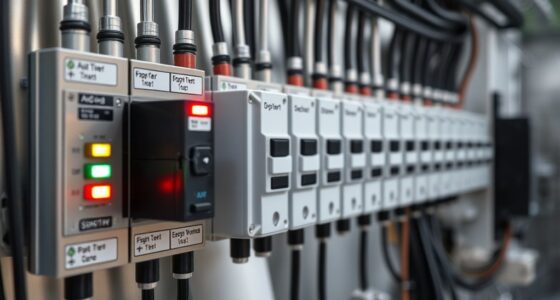Neutral switching in ATS systems is vital for safety and reliable power transfer. It guarantees proper grounding, prevents ground loops, and maintains system stability. Improper switching can cause dangerous faults or equipment damage. Understanding the difference between break-before-make and make-before-break transfer types, along with safe wiring practices, helps avoid hazards. Keeping these details in mind makes your system safer and more dependable. Explore further to reveal essential insights most pros wish you knew.
Key Takeaways
- Proper neutral switching ensures system stability, prevents ground loops, and maintains safe reference connections during transfer operations.
- Incorrect neutral switching can cause ground faults, electrical shocks, equipment damage, and increased fire risk.
- Neutral transfer methods include mechanical relays and solid-state devices, each with specific advantages and safety considerations.
- Following industry best practices—like regular inspections, correct wiring, and proper timing—minimizes hazards and maintains system reliability.
- Understanding transfer types (break-before-make vs. make-before-break) is crucial for managing power quality and system continuity.
Understanding the Role of the Neutral in ATS Systems

The neutral plays a essential role in Automatic Transfer Switch (ATS) systems by providing a return path for electrical current. Neutral grounding is fundamental for safety, preventing unwanted voltage buildup and protecting equipment from faults. When properly grounded, the neutral helps maintain system stability and reduces electrical noise. In ATS systems, the neutral also contributes to system isolation, ensuring that during transfer operations, the electrical circuits remain properly referenced and isolated from faults or disturbances. This isolation helps prevent faults from spreading and maintains the integrity of both the utility and backup power sources. Understanding how the neutral functions in grounding and system isolation is key for ensuring safe, reliable transfer operations and protecting your electrical infrastructure from potential issues. Proper neutral management is also essential for minimizing electromagnetic interference (EMI) and ensuring compliance with electrical standards.
When and Why Neutral Switching Occurs During Transfer Operations

Have you ever wondered why neutral switching happens during transfer operations in an ATS system? Neutral switching occurs primarily to address grounding issues and guarantee proper neutral connection continuity. This process typically happens when the load on the source changes or if there’s a grounding concern that needs correction. Specifically, neutral switching is triggered to: 1. Prevent ground loops that could cause equipment damage 2. Maintain safe and reliable neutral connection during transfer 3. Isolate grounding issues that might lead to voltage fluctuations or faults which are critical in maintaining electrical safety and system stability.
The Differences Between Break-Before-Make and Make-Before-Break Transfer Types

You need to understand how transfer timing varies between break-before-make and make-before-break types. These differences can impact system reliability and how smoothly your transfer occurs. Recognizing these distinctions helps you choose the right transfer method for your application’s stability. Additionally, understanding wall organization systems can aid in creating a more efficient and visually appealing setup to support seamless operation.
Transfer Timing Variations
Understanding transfer timing variations is essential when working with ATS neutral switching, as different transfer types impact system reliability and downtime. The two main types—break-before-make and make-before-break—have distinct effects on power quality and system grounding. A proper grasp of fatherhood and the importance of support can help in designing systems that align with best practices. 1. Break-before-make ensures the current source is disconnected before connecting to the new source, reducing overlap but risking brief outages. 2. Make-before-break creates a temporary connection to both sources, maintaining continuous power but potentially causing power quality issues. 3. Transfer timing influences the risk of transient voltages and disturbances, which can affect sensitive equipment. Choosing the right transfer timing depends on your system’s grounding setup and the need for seamless power continuity, minimizing disruptions during transfers.
System Reliability Impact
The choice between break-before-make and make-before-break transfer types directly affects system reliability by influencing how smoothly power can switch between sources. With break-before-make, there’s a brief interruption, which can momentarily disturb power stability and impact neutral grounding. This may cause transient voltages and potential system stress, risking equipment damage or downtime. Conversely, make-before-break provides a seamless transfer, maintaining continuous power flow and preserving neutral grounding connections. This approach enhances power stability, reducing the risk of voltage fluctuations or system faults during switching. Your selection impacts overall reliability, especially in critical systems where uninterrupted power is essential. Understanding these differences helps ensure your transfer switch optimizes system performance and maintains consistent, stable power delivery. Additionally, incorporating advanced techniques can further improve switching performance and system resilience.
Common Methods for Neutral Switching in Automatic Transfer Switches

There are two main methods used for neutral switching in automatic transfer switches: mechanical transfer mechanisms and solid-state switching techniques. Mechanical methods rely on physical contacts to switch the neutral, while solid-state methods use electronic components for faster, more reliable operation. Understanding these methods helps you choose the right approach for your specific application. Additionally, the increasing reliance on digital payment solutions underscores the importance of secure and efficient transfer switch methods to protect sensitive data.
Mechanical Transfer Mechanisms
How do mechanical transfer mechanisms guarantee reliable neutral switching in automatic transfer switches? They use physical components, like transfer relays and contactors, to switch the neutral grounding seamlessly between sources. This guarantees continuous grounding and prevents potential faults. Mechanical systems are designed for durability and quick response, maintaining proper isolation during switching. Additionally, the choice of materials and design features can influence the system’s overall performance and longevity.
Solid-State Switching Techniques
Solid-state switching techniques have become a popular choice for neutral switching in automatic transfer switches due to their fast response times and high reliability. These methods use semiconductor devices like TRIACs or thyristors to switch the neutral connection seamlessly, reducing wear and maintenance. Proper grounding practices are essential here, ensuring safe operation and preventing electrical faults. Additionally, surge suppression is critical to protect the switch’s sensitive components from voltage spikes caused by lightning or power fluctuations. By integrating surge suppressors, you enhance system longevity and stability. Solid-state switching not only improves response times but also minimizes electrical noise, providing a cleaner transfer process. Maintaining proper grounding is crucial for safety and system performance. Overall, these techniques offer a modern, efficient alternative to mechanical methods, making neutral switching safer and more reliable in critical power applications.
Potential Risks and Hazards Associated With Neutral Switching

Neutral switching, if not performed correctly, can pose significant safety risks and electrical hazards. Incorrect switching may lead to ground faults, where unintended current flows to the ground, increasing shock risk. It can also compromise insulation testing, making it harder to detect deteriorating or damaged insulation that could cause shorts or fires. Additionally, improper neutral switching can cause voltage imbalances, damaging sensitive equipment or creating unpredictable power flow. Understanding the importance of proper toilet maintenance and repairs can help prevent some electrical issues related to improper switching. Key hazards include: 1. Increased risk of electrical shock due to unexpected current paths. 2. Potential for equipment damage from voltage fluctuations. 3. Elevated danger of ground faults that can trigger fires or injury. To minimize these risks, proper procedures and safety measures are essential when handling neutral switching in ATS systems.
Proper Wiring and Setup to Ensure Safe Neutral Transition

Ensuring proper wiring and setup is critical for a safe neutral changeover in ATS systems. Correct wiring configurations prevent accidental back-feeding, while proper grounding practices guarantee safety and system stability. Use dedicated neutral and ground connections, and verify that wiring is consistent with manufacturer guidelines. Proper setup minimizes risks and ensures smooth transitions between power sources.
| Wiring Practice | Grounding Practice | System Reliability |
|---|---|---|
| Correct neutral wiring | Proper grounding connections | Consistent switching |
| Segregated wiring runs | Grounding for safety | Reduced faults |
| Color-coded wiring | Continuous grounding conductors | Stable operation |
| Secure connections | Ground testing procedures | Enhanced safety |
| Regular inspection | Proper grounding earthing | System longevity |
Troubleshooting Neutral Switching Problems in ATS Units

Proper wiring and setup set the foundation for reliable neutral switching in ATS units. When troubleshooting issues, start by inspecting the switch contact points to ensure they’re clean and making solid contact during switching. Poor contact can cause unreliable neutral transfer, leading to system faults. Next, verify proper neutral grounding; improper grounding can create voltage imbalances that hinder neutral switching. Finally, check the control wiring for any loose connections or damage that could disrupt signals intended to trigger the transfer process. Ensuring correct contrast ratio in your system can also affect overall performance, especially in scenarios with varying lighting conditions. Consider these steps: 1. Confirm switch contact integrity and cleanliness. 2. Ensure neutral grounding is correctly connected and secure. 3. Inspect control wiring for loose or damaged connections. Addressing these issues helps prevent neutral switching problems and ensures smooth operation.
Best Practices and Recommendations From Industry Experts

Industry experts emphasize that adopting standardized installation and maintenance procedures is key to achieving reliable neutral switching in ATS units. Proper neutral grounding guarantees stability and safety, reducing the risk of fault conditions. Maintaining precise switchgear coordination is essential to prevent misoperations and ensure seamless transfer between power sources. Regular inspections and testing of switchgear components help identify potential issues before they escalate. Use consistent grounding practices across all equipment to avoid ground loops or interference. Follow manufacturer guidelines for setup and calibration, and document all procedures thoroughly. Training personnel on neutral switching principles and safety protocols minimizes errors. By implementing these best practices, you enhance system reliability, ensure compliance, and extend the lifespan of your ATS units.
Frequently Asked Questions
How Does Neutral Switching Impact Overall System Reliability?
Neutral switching can improve system reliability by isolating grounding issues and reducing fault detection problems. When done correctly, it prevents neutral line faults from causing widespread outages, ensuring smoother operation. However, if mismanaged, it might introduce grounding issues or complicate fault detection, risking system stability. You should understand these impacts and maintain proper switching procedures to maximize reliability and minimize potential disruptions.
Are There Specific Scenarios Where Neutral Switching Is Unnecessary?
Think of neutral switching as a bridge that’s sometimes unnecessary, like when grounding issues are minimal and load balancing is stable. You don’t need it if your system’s grounding is solid, and loads are evenly distributed. In such cases, neutral switching adds complexity without benefits. When everything runs smoothly, skipping it keeps your system simpler, safer, and more reliable—saving effort and reducing potential faults.
What Are the Latest Technological Advancements in Neutral Switching?
You’ll find that the latest advancements in neutral switching focus on improved switchgear design and grounding safety. Modern switchgear incorporates smarter, more reliable neutral switching mechanisms that enhance safety and reduce faults. Innovations like integrated grounding safety features ensure better protection during switching operations. These technological upgrades make your system more robust, minimize risks, and guarantee compliance with safety standards, giving you peace of mind during critical switching processes.
How Does Neutral Switching Influence Power Quality and Noise?
Neutral switching improves power quality by reducing ground noise and maintaining voltage stability. When your ATS switches neutrals properly, it minimizes fluctuations and interference that can cause equipment to malfunction. This process ensures a cleaner, more stable power supply, preventing disturbances caused by ground noise. As a result, your systems run smoothly, with fewer disruptions, and you experience enhanced reliability and performance in your electrical setup.
Can Neutral Switching Be Automated for Predictive Maintenance?
You can automate neutral switching for predictive maintenance, enhancing battery safety and switch synchronization. By integrating smart controls and sensors, you enable seamless, proactive adjustments that prevent issues before they arise. Automation guarantees smoother transitions, reduces human error, and helps detect potential faults early. This proactive approach keeps your system reliable, minimizes downtime, and optimizes performance, all while maintaining a secure environment for your electrical setup.
Conclusion
Think neutral switching is just a simple switch? Think again. The truth is, it’s a complex process that can impact your system’s safety and reliability if not understood properly. Many believe neutral switching is harmless, but it can introduce risks if mishandled. By understanding how and when it happens, you can prevent potential hazards and ensure smooth, safe transfer operations. Don’t underestimate the importance of proper neutral management in your ATS system.









